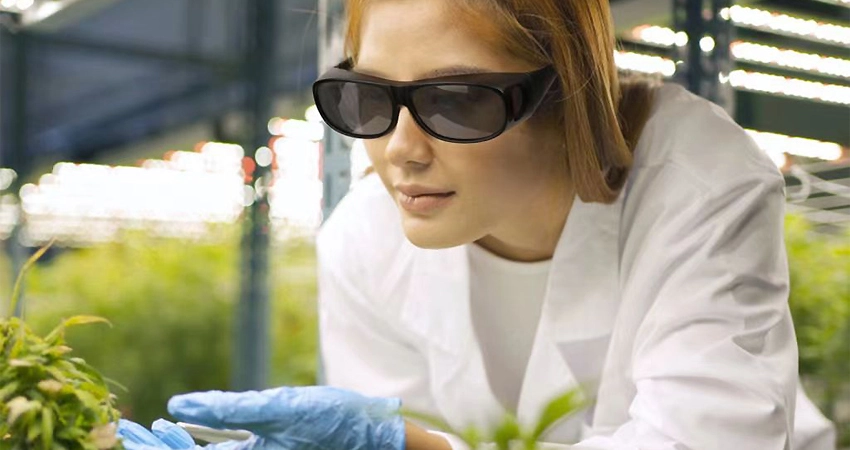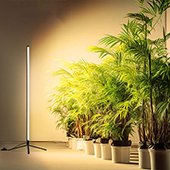Menu
Do You Need Grow Light Glasses in Grow Room?
When growing indoors using hydroponics or other growth mediums, it’s important to provide high levels of full-spectrum light and increased ultraviolet (UV) light. Some growers resort to using reflective hoods and mirrors to boost light levels, but this often comes at the expense of the growers’ vision.
The more light is used, the greater the risk of eye strain, fatigue, and reduced ability to observe crop conditions. In the commercial growing industry, prolonged exposure to UV light can also pose health and safety risks.
When you’re growing under artificial lighting, it’s crucial to use grow room glasses to protect your eyes. Reducing eye fatigue is a key aspect of optimizing the indoor gardening experience.
LED grow lights emit a lot of light, but much of it is invisible to the human eye. Our eyes aren’t good at capturing red and blue light waves, even though these wavelengths still affect our vision.
Blue light emitted by devices like computer screens and LED bulbs can cause eye strain and even damage to the cornea. Overexposure to blue light can lead to vision fading.
To address these issues and enhance your indoor gardening experience, LED grow light glasses are designed to completely block UV, and reduce glare, eye fatigue, and the negative effects of blue light.
By wearing them, you can increase visual endurance, alleviate eye strain, and improve your ability to identify and address any issues with your crops.
Why Do You Need to Protect Your Eyes?
To reduce eye fatigue, you’ll be able to focus on the details and complexities of plants, enabling you to make wise decisions and provide necessary care. Grow room glasses play a crucial role in maintaining both plant health and eye health, ensuring the best indoor gardening environment.
By closely inspecting your crops, you can spot early signs of problems, improve plant care, and take necessary remedial actions.
If you notice subtle changes in leaf color, such as yellow, red, or orange spotting, it may indicate a lack of minerals or vitamins in the plant. Similarly, browning along the leaf edges or failure of buds to fruit or open may also indicate nutrient deficiencies.
Subtle differences in discoloration and damage patterns, such as irregular margins or high-density necrotic tissue at the center of brown spots, may suggest fungal infection rather than vitamin or mineral deficiencies.
Mosaic patterns of discoloration are often associated with viral infections, which can be highly contagious and harmful to tomato crops if not accurately identified. Additionally, comparing leaves and stems and noting any changes in growth habits or deformities are crucial for maintaining robust and viable crops.
With the help of exclusive grow room glasses, you can carefully inspect these symptoms and distinguish them from other potential causes.
Greenhouse workers and professionals in the gardening industry must adhere to OSHA safety standards to ensure their health. One of the potential risks they face is exposure to UV light emitted by LED lights, which can be harmful to their eyes.
Grow light glasses offer a valuable solution by providing UV protection. The specialized eyewear not only protects workers’ eyes but also maintains their visual health in high-humidity environments, thanks to features like anti-fog lenses.
Just like sunglasses, grow room safety glasses can act as shields against harmful wavelengths emitted by lights. Besides protecting your eyes, these glasses also reduce glare, restore true colors, and allow you to better understand your growing area.
Unlike regular sunglasses, these glasses for grow room light are specifically designed for the types of lights used in grow rooms. The presence of lenses to shield your eyes from harm caused by LED, HPS, and CMH lighting systems. Choosing the right lenses for your growing operations is key to properly protecting your eyes and working in the grow room.
What Happens if You Don't Wear Grow Light Glasses?
If you’re using HID lights, always wear these glasses every time you go in! They emit enough UV light that, just like staring at a welding arc, they can burn your eyes. Many old-school cannabis growers have a lot of vision problems because of this.
According to the American Optometric Association, UV rays can cause various harmful effects. Some are short-term effects, while others are more serious long-term consequences.
Eye Strain and Dryness
Eye strain not only affects comfort during the growing process but may also decrease work efficiency and concentration. The high-intensity plant lights, especially those designed to promote photosynthesis in plants such as full-spectrum or specific wavelength LED grow lights, often emit much brighter light than typical indoor lighting.
Prolonged staring or working in such intense lighting conditions requires the eye muscles to continuously strain to adjust focus, which can accelerate eye muscle fatigue, leading to feelings of soreness, dryness, and even discomfort such as eye pain and headaches.
Vision Damage
Prolonged exposure to excessively bright light, especially without proper protection, can result in temporary or permanent vision impairment. Overexposure to light can cause degeneration of the cornea and lens, accelerating the onset of eye conditions such as cataracts.
The intense light may disrupt intraocular fluid circulation, increase eye pressure, and pose additional risks to individuals with glaucoma.
Blue Light Hazard
Many grow lights include a certain proportion of blue light to simulate natural light spectra, as blue light has higher energy, especially in the short-wave blue light spectrum.
Prolonged exposure to high concentrations of blue light can directly damage the photoreceptor cells on the retina, particularly the cone cells located in the macular region, which are crucial for central vision and color recognition.
Long-term accumulation of blue light damage may lead to serious eye conditions such as macular degeneration, affecting central visual acuity and color perception.
Disruption of Circadian Rhythm
Blue light also directly affects the human circadian rhythm by suppressing the secretion of melatonin, a hormone that regulates the sleep-wake cycle.
Prolonged exposure to blue light at night or in dark environments may disrupt normal sleep patterns, leading to issues such as insomnia, and circadian rhythm disorders, and ultimately affecting overall health and quality of life.
Skin and Eye Allergic Reactions
In rare cases, some individuals may experience allergic reactions to specific light sources, manifesting as itchy, swollen eyes, and even skin inflammation.
While not everyone encounters this issue without wearing protective eyewear, direct exposure to high-intensity plant lighting can exacerbate these symptoms for those with sensitive skin and eyes.

Other Protective Measures
- Set Reasonable Work Hours
To avoid prolonged exposure to high-intensity light, it’s recommended for growers to follow the “20-20-20” rule: Every 20 minutes of work, take a break by moving at least 20 feet away from the grow lights, and rest your eyes for 20 seconds by looking into the distance or closing them to relax.
Ensuring an adequate amount of non-light-exposed rest time each day helps alleviate eye strain and reduce blue light exposure.
- Maintain Proper Distance
When conducting daily plant management, it’s important to maintain a certain distance from the grow lights. Depending on the power and type of lighting fixtures, adjust the height of the grow racks or the position of the workbench to ensure that the distance between your eyes and the light source is sufficient to reduce direct exposure to intense light. For situations requiring close observation of plants, consider using magnifying glasses or microscopes with appropriate protective features instead of getting too close to the lights.
- Use Light Shields
For large-scale growing spaces or fixed work areas, consider installing transparent or semi-transparent light shields, such as anti-blue light glass or plastic panels, to reduce overall light intensity and blue light radiation.
Setting up reflector hoods or diffuser panels around the fixtures can also effectively scatter light and reduce the localized glare effect. For portable or handheld fixtures, opt for products with built-in light shields to minimize the impact of direct light on the eyes.
- Optimize Lighting Layout
Arrange lighting fixtures strategically based on plant requirements and the characteristics of the growing space to avoid concentrated light sources causing localized glare. Using evenly distributed light sources or multi-level lighting can meet the lighting needs of plants while reducing direct stimulation to the eyes.
For home garden enthusiasts, consider setting up a separate observation area outside the workspace with soft ambient lighting for close observation of plants without being disturbed by intense light.
- Regular Eye Examinations and Self-Care
Encourage growers to undergo regular eye health check-ups, including vision tests, eye pressure measurements, and retinal examinations, to promptly detect and address potential eye issues.
- Strengthen Awareness and Education on Protection
Advocate for a safe and healthy indoor gardening lifestyle, encouraging growers to enjoy gardening while actively learning and disseminating scientific knowledge on lighting management and eye protection techniques.
Get in touch with us!
From custom light planning, to tailored quotes, and everything in between, our team of horticulture experts are always ready to assist.




